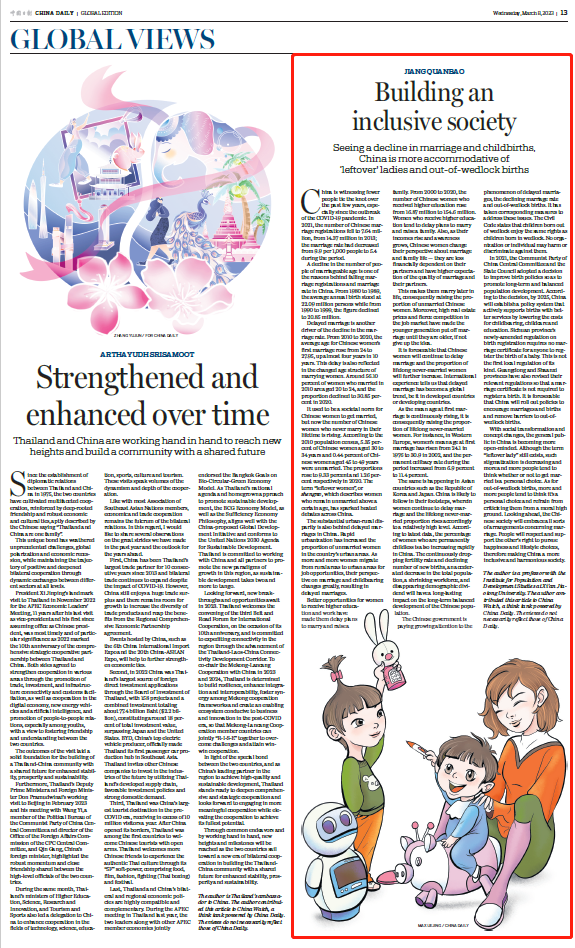
China is witnessing fewer people tie the knot over the past few years, especially since the outbreak of the COVID-19 pandemic. In 2021, the number of Chinese marriage registrations fell to 7.64 million, from 14.37 million in 2013; the marriage rate had decreased from 9.9 per 1,000 people to 5.4 during the period.
A decline in the number of people of marriageable age is one of the reasons behind falling marriage registrations and marriage rate in China. From 1980 to 1989, the average annual birth stood at 22.09 million persons while from 1990 to 1999, the figure declined to 20.85 million.
Delayed marriage is another driver of the decline in the marriage rate. From 2010 to 2020, the average age for Chinese women’s first marriage rose from 24 to 27.95, up almost four years in 10 years. This delay is also reflected in the changed age structure of marrying women. Around 56.10 percent of women who married in 2010 are aged 20 to 24, and the proportion declined to 30.85 percent in 2020.
It used to be a societal norm for Chinese women to get married, but now the number of Chinese women who never marry in their lifetime is rising. According to the 2010 population census, 5.35 percent of Chinese women aged 30 to 34 years and 0.44 percent of Chinese women aged 45 to 49 years were unmarried. The proportions rose to 9.33 percent and 1.26 percent respectively in 2020. The term “leftover women”, or shengnv, which describes women who remain unmarried above a certain age, has sparked heated debates across China.
The substantial urban-rural disparity is also behind delayed marriages in China. Rapid urbanization has increased the proportion of unmarried women in the country’s urban areas. As more and more women migrate from rural areas to urban areas for job opportunities, their perspective on marriage and childbearing changes greatly, resulting in delayed marriages.
Better opportunities for women to receive higher education and work have made them delay plans to marry and raise a family. From 2000 to 2020, the number of Chinese women who received higher education rose from 16.87 million to 154.6 million.Women who receive higher education tend to delay plans to marry and raise a family. Also, as their incomes rise and awareness grows, Chinese women change their perspective about marriage and family life — they are less financially dependent on their partners and have higher expectation of the quality of marriage and their partners.
This makes them marry later in life, consequently raising the proportion of unmarried Chinese women. Moreover, high real estate prices and fierce competition in the job market have made the younger generation put off marriage until they are older, if not give up the idea.
It is foreseeable that Chinese women will continue to delay marriage and the proportion of lifelong never-married women will further increase. International experience tells us that delayed marriage has become a global trend, be it in developed countries or developing countries.
As the mean age at first marriage is continuously rising, it is consequently raising the proportion of lifelong never-married women. For instance, in Western Europe, women’s mean age at first marriage has risen from 24.1 in 1976 to 30.9 in 2002, and the permanent celibacy rate during the period increased from 6.9 percent to 11.4 percent.
The same is happening in Asian countries such as the Republic of Korea and Japan. China is likely to follow in their footsteps, wherein women continue to delay marriage and the lifelong never-married proportion rises accordingly to a relatively high level. According to latest data, the percentage of women who are permanently childless is also increasing rapidly in China. The continuously dropping fertility rate and declining number of new births, an accelerated decrease in the total population, a shrinking workforce, and disappearing demographic dividend will have a long-lasting impact on the long-term balanced development of the Chinese population.
The Chinese government is paying growing attention to the phenomenon of delayed marriages, the declining marriage rate and out-of-wedlock births. It has taken corresponding measures to address these issues. The Civil Code states that children born out of wedlock enjoy the same rights as children born in wedlock. No organization or individual may harm or discriminate against them.
In 2021, the Communist Party of China Central Committee and the State Council adopted a decision to improve birth policies so as to promote long-term and balanced population development. According to the decision, by 2025, China will establish a policy system that actively supports births with better services by lowering the costs for childbearing, childcare and education. Sichuan province’s newly-amended regulation on birth registration requires no marriage certificate for anyone to register the birth of a baby. This is not the first local regulation of its kind. Guangdong and Shaanxi provinces have also revised their relevant regulations so that a marriage certificate is not required to register a birth. It is foreseeable that China will roll out policies to encourage marriages and births and remove barriers to out-of-wedlock births.
With social transformation and concept changes, the general public in China is becoming more open-minded. Although the term “leftover lady” still exists, such stigmatization is decreasing and more and more people tend to think whether or not to get married is a personal choice. As for out-of-wedlock births, more and more people tend to think it’s a personal choice and refrain from criticizing them from a moral high ground. Looking ahead, the Chinese society will embrace all sorts of arrangements concerning marriage. People will respect and support the other’s right to pursue happiness and lifestyle choices, therefore making China a more inclusive and harmonious society.